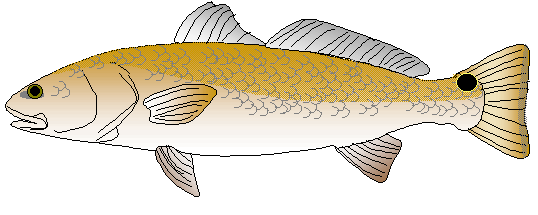Name/Relations || Range/Sizes || Habitat & Habits || Notes
 |
 |
| Spot(s) on the tail, no teeth (raspers can scrape skin however) |
Common Name:
Red Drum
Other Common Names:
Redfish, puppy Drum, drum, Channel Bass
Scientific name:
Sciaenops ocellatus
Family: Sciaenidae
(Drums)
Related Species:
Black Drum, Atlantic Croaker, Southern Kingfish
| Range: Atlantic from Massachusetts to Cuba, including the entire Gulf of Mexico and Chesepeake Bay. |
Sizes: Possible
to 85lbs, common 1lb-20lbs.
Habitat: Estruaries, Bays, marshes, inlets, oysterbeds and weedbeds in inshore and nearshore salt and brakish waters to 200 feet deep. Prefers water in the 70's and lower 80's F. Water in the low 50's for extended periods can be fatal if the fish cannot seek deeper water.
Spawning Habits: Spawns fall in shallow open water to 200 feet. Groups of fish gather in large schools and drop the fertilized eggs which drift until hatching. The young swim into bays and estuaries to grow. Females are larger and take up to 5 years for first spawning (like many drums).
Feeding Habits:
Smaller fish feed in schools near shallow grassbeds and oyster beds on
tide changes, especially in the early morning or late evening. Commonly
feeds in schools and packs in and near the surf, around shallow reefs,
and in bays and inlets. Large reds often hide behind pillings in
channels, poping out to pounce on any edible tidbit. Feeds on molluscs
(squid, clams, mussels, oysters), crabs, shrimp, and minnows (menhaden,
herrings, anchovies, mullet, pinfish, croakers), even as large fish.
Will chase schools of baitfish into shallow water, and also often can be
seen 'tailing' in shallow water when it pokes its nose into the sand in
search of food.
Notes:
Very omnivourous and popluar for sport and table, its popularity almost
brought this species to extinction. After extremely tight management
and some stocking, as well as net bans in some areas, the population has
again recovered to healthy levels. Commonly stocked in Texas and
Florida in a marine hatchery program. The red will take a wide variety
of flies, lures, and baits, but can be both very picky and very aggressive.
A common surf fisher's target from Maryland to Florida and around the Gulf
to Texas. It is also caught off piers and bridges, in the flats of
bays, bayous, near oysterbeds and grass flats, in deep channels in passes
and bays. Good flies include clousers, streamers, and poppers; lures
such as plugs, poppers, twitchbaits, and spoons are effective; baits such
as live shrimp, fresh squid, clams, crabs, mullet, croakers, and pinfish
are effective either freelined or fished near the bottom. Watch the tide
changes for prime actions.